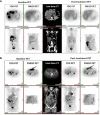Evaluation of 18F-FMISO PET and 18F-FDG PET Scans in Assessing the Therapeutic Response of Patients With Metastatic Colorectal Cancer Treated With Anti-Angiogenic Therapy
- PMID: 33816239
- PMCID: PMC8010243
- DOI: 10.3389/fonc.2021.606210
Evaluation of 18F-FMISO PET and 18F-FDG PET Scans in Assessing the Therapeutic Response of Patients With Metastatic Colorectal Cancer Treated With Anti-Angiogenic Therapy
Abstract
Introduction: Tumor hypoxia and angiogenesis are implicated in tumor growth and metastases, and anti-angiogenic therapies have an important role in treating patients with metastatic colorectal cancer. However, the prevalence of hypoxia has not been fully evaluated in colorectal liver metastases, and hypoxic response to anti-angiogenic therapy has not been clearly established. The aims of the study were to evaluate the changes seen on 18F-FMISO and 18F-FDG PET scans in patients treated with anti-angiogenic therapy, and to correlate these measures of hypoxia and metabolism with clinical outcomes, and blood biomarkers of angiogenesis.
Methods: Patients with metastatic colorectal carcinoma planned for treatment with bevacizumab and chemotherapy received routine staging investigations prior to any treatment, including a FDG PET scan. A FMISO PET scan was performed within 4 weeks of staging tests, with blood specimens collected at that time for serum VEGF and osteopontin measurement. Follow-up FDG and FMISO scans were performed after 1 cycle of treatment. Results were compared to response (RECIST), progression free survival (PFS), and overall survival (OS).
Results: A total of 15 patients were recruited into this prospective trial, of which 13 patients were evaluable for assessment of treatment follow-up. Baseline FDG uptake was higher than FMISO uptake, and there was a significant decrease in FDG uptake (SUVmax and TGV) but not FMISO uptake (SUVmax and TNR) after treatment. There was a positive correlation between FDG and FMISO SUVmax on both baseline and post-treatment PET scans. Blood biomarkers of serum VEGF and osteopontin were significantly correlated with the FDG and FMISO PET parameters.
Conclusions: This study shows that hypoxia in metastatic colorectal cancer, assessed by FMISO PET, shows minor changes following initial treatment with anti-angiogenic therapy, but is associated with therapeutic response. FDG PET uptake changes (SUVmax, TLG) are also associated with response to anti-angiogenic therapy. These findings demonstrate the interplay between tumor metabolism and hypoxic regulation following anti-angiogenic treatment of metastatic colorectal cancer.
Keywords: angiogenesis; bevacizumab; fluoromisonidazole (FMISO) positron emission tomography (PET); hypoxia; metastatic colorectal carcinoma; response.
Copyright © 2021 Lee, Tebbutt, Gan, Liu, Sachinidis, Pathmaraj and Scott.
Conflict of interest statement
The authors declare that the research was conducted in the absence of any commercial or financial relationships that could be construed as a potential conflict of interest.
Figures




Similar articles
-
Prediction of Response to Anti-Angiogenic Treatment for Advanced Colorectal Cancer Patients: From Biological Factors to Functional Imaging.Cancers (Basel). 2024 Mar 30;16(7):1364. doi: 10.3390/cancers16071364. Cancers (Basel). 2024. PMID: 38611042 Free PMC article. Review.
-
Prevalence of hypoxia and correlation with glycolytic metabolism and angiogenic biomarkers in metastatic colorectal carcinoma.Eur J Nucl Med Mol Imaging. 2021 May;48(5):1585-1592. doi: 10.1007/s00259-020-05074-5. Epub 2020 Oct 30. Eur J Nucl Med Mol Imaging. 2021. PMID: 33125527
-
[(18)F]FMISO and [(18)F]FDG PET imaging in soft tissue sarcomas: correlation of hypoxia, metabolism and VEGF expression.Eur J Nucl Med Mol Imaging. 2003 May;30(5):695-704. doi: 10.1007/s00259-002-1096-7. Epub 2003 Mar 11. Eur J Nucl Med Mol Imaging. 2003. PMID: 12632200 Clinical Trial.
-
Assessment of biological parameters in head and neck cancer based on in vivo distribution of 18F-FDG-FLT-FMISO-PET/CT images.Tumori. 2020 Feb;106(1):33-38. doi: 10.1177/0300891619868012. Epub 2019 Aug 26. Tumori. 2020. PMID: 31446858
-
Imaging Techniques for Treatment Evaluation for Metastatic Breast Cancer [Internet].Rockville (MD): Agency for Healthcare Research and Quality (US); 2014 Oct. Report No.: 14-EHC044-EF. Rockville (MD): Agency for Healthcare Research and Quality (US); 2014 Oct. Report No.: 14-EHC044-EF. PMID: 25375016 Free Books & Documents. Review.
Cited by
-
Predicting the hypoxic volume of head and neck tumors from fluorodeoxyglucose positron emission tomography images using artificial intelligence.Phys Imaging Radiat Oncol. 2025 Apr 17;34:100769. doi: 10.1016/j.phro.2025.100769. eCollection 2025 Apr. Phys Imaging Radiat Oncol. 2025. PMID: 40584457 Free PMC article.
-
Impact of Hypoxia on Radiation-Based Therapies for Liver Cancer.Cancers (Basel). 2024 Feb 22;16(5):876. doi: 10.3390/cancers16050876. Cancers (Basel). 2024. PMID: 38473237 Free PMC article. Review.
-
Prediction of Response to Anti-Angiogenic Treatment for Advanced Colorectal Cancer Patients: From Biological Factors to Functional Imaging.Cancers (Basel). 2024 Mar 30;16(7):1364. doi: 10.3390/cancers16071364. Cancers (Basel). 2024. PMID: 38611042 Free PMC article. Review.
-
Noninvasive Stratification of Colon Cancer by Multiplex PET Imaging.Clin Cancer Res. 2024 Apr 15;30(8):1518-1529. doi: 10.1158/1078-0432.CCR-23-1063. Clin Cancer Res. 2024. PMID: 38493804 Free PMC article.
-
[18F]FMISO PET in metastatic neuroendocrine tumours: a pilot study.Asia Ocean J Nucl Med Biol. 2025;13(2):117-125. doi: 10.22038/aojnmb.2025.83664.1611. Asia Ocean J Nucl Med Biol. 2025. PMID: 40585285 Free PMC article.
References
-
- Modest DP, Ricard I, Heinemann V, Hegewisch-Becker S, Schmiegel W, Porschen R, et al. . Outcome according to KRAS-, NRAS- and BRAF-mutation as well as KRAS mutation variants: pooled analysis of five randomized trials in metastatic colorectal cancer by the AIO colorectal cancer study group. Ann Oncol (2016) 27(9):1746–53. 10.1093/annonc/mdw261 - DOI - PMC - PubMed
LinkOut - more resources
Full Text Sources
Other Literature Sources
Research Materials

